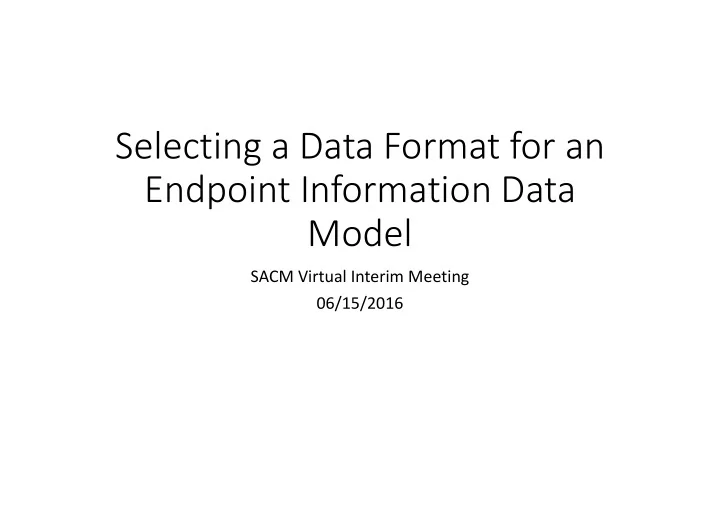

Selecting a Data Format for an Endpoint Information Data Model SACM Virtual Interim Meeting 06/15/2016
Agenda • Considerations (pertaining to data formats) • Introductions • CBOR • JSON • XML • Detailed Observations • Next Steps
Considerations • Meets SACM Requirements 1 • Supports SACM IM 2 • Easy to document/understand examples? • PROs and CONS with respect to SACM For example, some may complain that • Technical Features? JSON doesn’t do comments. But this isn’t • Compatibility Needs? relevant unless SACM data formats need • Others? to have comments. 1. https://datatracker.ietf.org/doc/draft-ietf-sacm-requirements/ 2. https://datatracker.ietf.org/doc/draft-ietf-sacm-information-model/
SACM Requirement Considerations • SACM requirements which could affect choosing a data format • DM-003 Search Flexibility • DM-006 Data Cardinality • DM-016 Transport Agnostic • There may be others… • Do we want a data model which supports relevant SHOULD requirements as well MUST requirements? • Do we want to consider associated schema languages?
Concise Binary Object Representation (CBOR) 1 • CBOR is a compact, binary data format • Potential PROs • Small footprint for encoding/decoding software • Data compactness • CBOR Data Definition Language (CDDL) 2 provides a way to express structures • Potential CONS • Encoder/Decoder software availability? • Not human readable (i.e., more than a text editor is required) 1. http://tools.ietf.org/html/rfc7049 2. https://datatracker.ietf.org/doc/draft-greevenbosch-appsawg-cbor-cddl/
JavaScript Object Notation (JSON) 1 • JSON is a simple, text-based data interchange format • Potential PROs • Simple • Rapid adoption taking place • Potential CONs • Ambiguous data item ordering and name uniqueness (explained and addressed in I-JSON 2 ) • Status of JSON Schema? 1. https://tools.ietf.org/html/rfc7159 2. https://tools.ietf.org/html/rfc7493
Extensible Markup Language (XML) 1 • XML is a text-based markup language for exchanging data • Potential PROs • Established • Variety of standardized (and optional) capabilities • Namespaces • Potential CONs • Verbose • Complex • Namespaces 1. http://www.w3.org/XML/
Relationship Between CBOR and JSON • Underlying data model is an extension of the JSON data model • All JSON types map directly to CBOR • Some CBOR types do not have an analog in JSON • An objective of CBOR is to support all JSON data types for conversion to and from JSON • JSON to CBOR conversion seems straightforward. The major question is what binary number representation(s) to use for translated numeric values. • CBOR to JSON conversion is more complex. Non-normative guidelines are given in the CBOR spec • Designing the data in JSON, and using CBOR as a compact, on-the-wire format, may be a useful strategy • CDDL may be leveraged to design the data structures we care about
Constraints on JSON Objects • JSON Data Interchange Format (ECMA-404) 1 does not specify: • Whether or not the order of object members is significant • Uniqueness requirements for object member names (i.e., are duplicate names allowed?) • JSON Data Interchange Format (RFC 7149) 2 • “JSON parsing libraries have been observed to differ as to whether or not they make the ordering of object members visible to calling software.” “ When the names within an object are not unique, the behavior of software that receives • such an object is unpredictable. ” • Internet JSON (I-JSON) Message Format (RFC 7493) 3 • “The order of object members in an I-JSON message does not change the meaning of an I- JSON message.” • Objects in I-JSON messages MUST NOT have members with duplicate names.” 1. www.ecma-international.org/publications/files/ECMA-ST/ECMA-404.pdf 2. https://tools.ietf.org/html/rfc7159 3. https://tools.ietf.org/html/rfc7493
Impact of JSON Object Constraints on IM Data Models • JSON Objects shouldn’t be used to represent: • Ordered lists • Lists which use the same data item more than once • An alternative is to employ JSON arrays to represent SACM lists • Order of array components is significant (spec is clear on that) • SACM data item names can be treated as data in JSON rather than as a data item
Constraints on XML Content Models • There is mixed/limited support for open content models • A validating XML processor is supposed to fail when encountering an invalid XML instance • DTD has no support for open content • In XML Schema, all elements are considered closed unless special data-types or constructs are used (e.g., xs:any, xs:opencontent)
Impact of XML Content Model on IM Data Models • Since open content cannot be assumed, neither can extensibility of data elements • Information element extensibility must be explicitly accounted for in the data model design • For instance, an XML schema would need to specify when/how extensibility is permitted
Next Steps • Perform a detailed analysis of the SACM Requirements and how they influence the selection of a data format • Work towards selecting a data format to develop an endpoint information data model
References
Concise Binary Object Representation (CBOR) • CBOR site (http://cbor.io/) • RFC-7049 (http://tools.ietf.org/html/rfc7049) • CDDL (https://datatracker.ietf.org/doc/draft-greevenbosch-appsawg- cbor-cddl/)
JavaScript Object Notation (JSON) • JSON Site (http://www.json.org/) • ECMA-404 (http://www.ecma- international.org/publications/standards/Ecma-404.htm) • RFC-7159 (https://tools.ietf.org/html/rfc7159) • RFC-7493 (https://tools.ietf.org/html/rfc7493) • JSON Schema Site (http://json-schema.org/) • JSON Schema in IETF (https://tools.ietf.org/html/draft-zyp-json- schema-04)
Extensible Markup Language (XML) • W3C XML Site (http://www.w3.org/XML/) • XML 1.0 (http://www.w3.org/TR/2008/REC-xml-20081126/) • XML Schema 1.1 (http://www.w3.org/XML/Schema) • Namespaces in XML 1.0 (http://www.w3.org/TR/2006/REC-xml- names-20060816/) • Namespaces in XML 1.1 (http://www.w3.org/TR/2006/REC-xml- names11-20060816/)
Recommend
More recommend